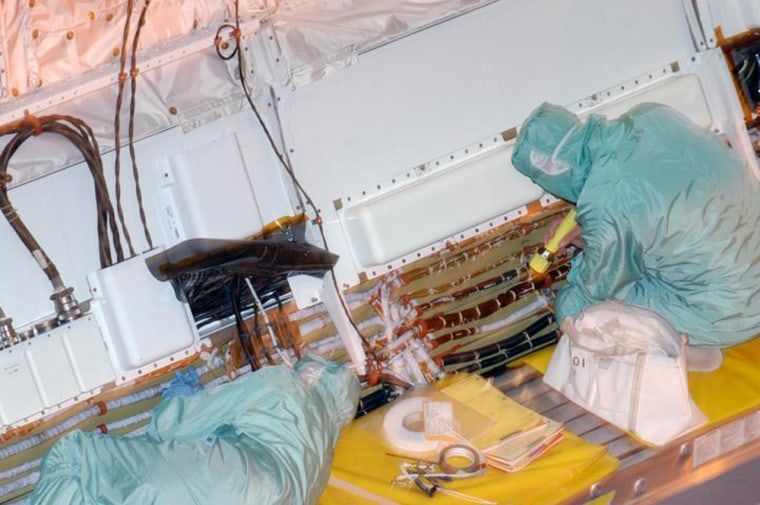A potential wiring problem detected on the shuttle Discovery has added a new twist to the preparations for the first space shuttle mission in two years, NASA confirmed Friday.
The additional work on the wiring in the shuttle's payload bay will delay its transfer from its hangar at Kennedy Space Center in Florida to the nearby Vehicle Assembly Building, NASA said. Earlier in the week, sources told NBC News' Jay Barbree that Discovery's scheduled May 15 launch might have to be postponed because the preparations were behind schedule.
The latest snag arose because workers checking out another shuttle in NASA's fleet, Endeavour, discovered that the fasteners for some of the wire trays in Endeavour's payload bay were chafing on the wires themselves.
That led mission managers to call for the same parts to be checked on Discovery as well, and the agency said "some wires will require additional work."
"The wire tray covers will be removed and chafe protection will be added," NASA said in Friday's status report. "Work on seal installations and cycle checks on the main and nose landing gear doors are almost complete."
Reshaping the schedule
Mission managers had planned to move the Discovery orbiter to the 52-story Vehicle Assembly Building on Tuesday, but because of the extra work, that "rollover" was postponed to March 27 or so.
After the rollover, the orbiter is to be mated with its external fuel tank and solid rocket boosters, which are already waiting inside the Vehicle Assembly Building. That job takes about a week. Based on the current schedule, the shuttle would be ready for its "rollout" to Launch Pad 39B in early April.
Discovery's seven crew members, led by commander Eileen Collins, are due to visit Kennedy Space Center for a practice countdown at the launch pad during the last week of April, NASA spokeswoman Jessica Rye said.
Rye said the schedule was set up with built-in leeway for contingencies, and shuttle managers can accelerate the work on Discovery by adding extra work crews if necessary.
NASA has said that the earliest window of opportunity for launch runs from May 15 to June 3, so a delay of only a few days would be well within the space agency's expectations. If Discovery misses the May-June window, another window would open up in July, when the shuttle Atlantis is currently scheduled for launch.
Testing NASA's 'safety culture'
Discovery's launch would mark the NASA shuttle fleet's return to flight after the breakup of the shuttle Columbia during atmospheric re-entry on Feb. 1, 2003 — a tragedy that killed all seven astronauts on board and prompted the fleet's grounding. After months of study, the Columbia Accident Investigation Board said lapses in NASA's "safety culture" helped set the stage for the tragedy.
NBC News space analyst James Oberg said the final weeks of preparation for Discovery's flight could once again put NASA's safety culture to the test.
"The question is, does the need to hit such a launch window, or suffer a significant delay waiting for the next window, create a conscious or unconscious urge to push ahead — like the guy jumping the turnstile in the subway to get to a train that's about to leave, rather than just wait for the next train," Oberg told MSNBC.com via e-mail.
Mission's key purposes
The key purposes of Discovery's mission are to deliver much-needed supplies to the international space station and test procedures that were developed in response to recommendations from the Columbia Accident Investigation Board.
The board concluded that Columbia's breakup likely occurred because a piece of foam insulation broke off from the shuttle's external fuel tank just after liftoff and damaged the left wing's leading edge. The hole in the wing allowed superheated gases to get inside Columbia during its atmospheric re-entry, destroying the craft from within.
NASA responded to the findings by redesigning the fuel tank, setting up new camera systems to monitor the shuttle during liftoff, and devising new procedures for inspecting and repairing the shuttle's protective outer skin during flight.
